AIDL的用法
定义接口,IRemoteService.aidl
1
2
3
4
5
6
| package com.ly.studydemo.binder;
import com.ly.studydemo.binder.MyData;
interface IRemoteService {
int getPid();
MyData getMyData();
}
|
编译器自动生成两个类:
- 服务端:IRemoteService.Stub,继承Binder,真正的服务提供者
- 客户端:IRemoteService.Stub.Proxy,实现接口IRemoteService,与服务端通信,请求和结果传输
服务端通过继承IRemoteService.Stub,提供服务:
1
2
3
4
5
6
7
8
9
10
11
12
|
private val mBinder: IRemoteService.Stub = object:IRemoteService.Stub() {
override fun getPid(): Int {
Log.i(TAG, "[RemoteService] getPid()=${android.os.Process.myPid()}")
return android.os.Process.myPid()
}
override fun getMyData(): MyData? {
Log.i(TAG, "[RemoteService] getMyData()=${this@RemoteService.mMyData}")
return this@RemoteService.mMyData
}
}
|
客户端(如Activity)获取到IBinder对象后,转换为接口对象使用:
1
| IRemoteService remoteService = IRemoteService.Stub.asInterface(service);
|
客户端要获取IBinder对象有两种方式:
- 异步获取:通过绑定Service获取
- 同步获取:通过ContentProvider获取
整体过程如下图所示:
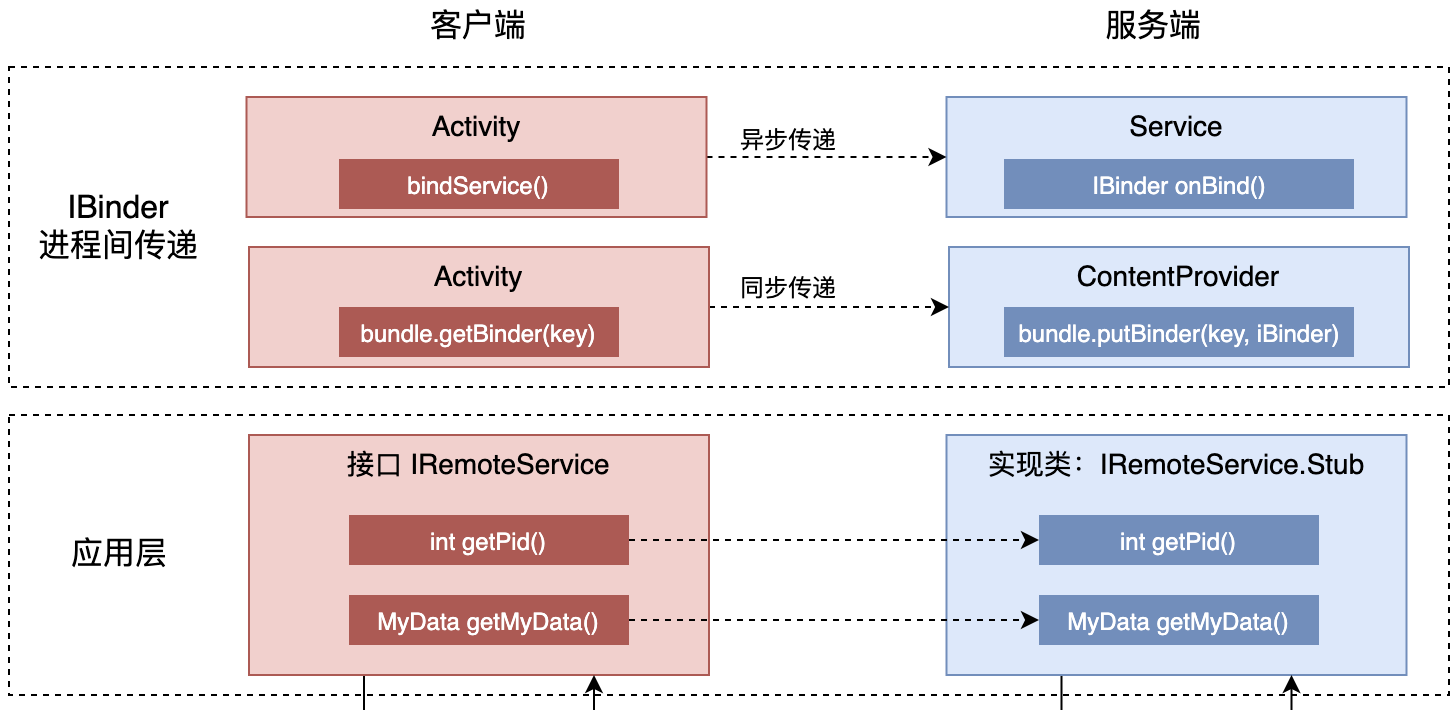
IRemoteService.Stub源码分析
由于是跨进程通过,不可能真正持有IRemoteService的实现类,客户端持有仅仅只是一个Proxy对象。
1
2
3
4
5
6
7
8
9
10
11
12
13
14
15
16
17
18
19
20
21
22
23
24
25
26
27
28
29
30
31
32
33
34
35
36
37
38
39
40
41
42
43
44
45
46
47
48
49
50
51
52
53
54
55
56
57
58
59
60
61
62
| private static class Proxy implements com.ly.studydemo.binder.IRemoteService {
private android.os.IBinder mRemote;
Proxy(android.os.IBinder remote) {
mRemote = remote;
}
@Override
public android.os.IBinder asBinder() {
return mRemote;
}
public java.lang.String getInterfaceDescriptor() {
return DESCRIPTOR;
}
@Override
public int getPid() throws android.os.RemoteException {
android.os.Parcel _data = android.os.Parcel.obtain();
android.os.Parcel _reply = android.os.Parcel.obtain();
int _result;
try {
_data.writeInterfaceToken(DESCRIPTOR);
boolean _status = mRemote.transact(Stub.TRANSACTION_getPid, _data, _reply, 0);
if (!_status && getDefaultImpl() != null) {
return getDefaultImpl().getPid();
}
_reply.readException();
_result = _reply.readInt();
} finally {
_reply.recycle();
_data.recycle();
}
return _result;
}
@Override
public com.ly.studydemo.binder.MyData getMyData() throws android.os.RemoteException {
android.os.Parcel _data = android.os.Parcel.obtain();
android.os.Parcel _reply = android.os.Parcel.obtain();
com.ly.studydemo.binder.MyData _result;
try {
_data.writeInterfaceToken(DESCRIPTOR);
boolean _status = mRemote.transact(Stub.TRANSACTION_getMyData, _data, _reply, 0);
if (!_status && getDefaultImpl() != null) {
return getDefaultImpl().getMyData();
}
_reply.readException();
if ((0 != _reply.readInt())) {
_result = com.ly.studydemo.binder.MyData.CREATOR.createFromParcel(_reply);
} else {
_result = null;
}
} finally {
_reply.recycle();
_data.recycle();
}
return _result;
}
public static com.ly.studydemo.binder.IRemoteService sDefaultImpl;
}
|
通过mRemote.transact(),以code的方式传递需要调用的方法名,服务端收到code码后,会调用IRemoteService.Stub的实现类的对应方法,这就是远程过程调用(RPC)。
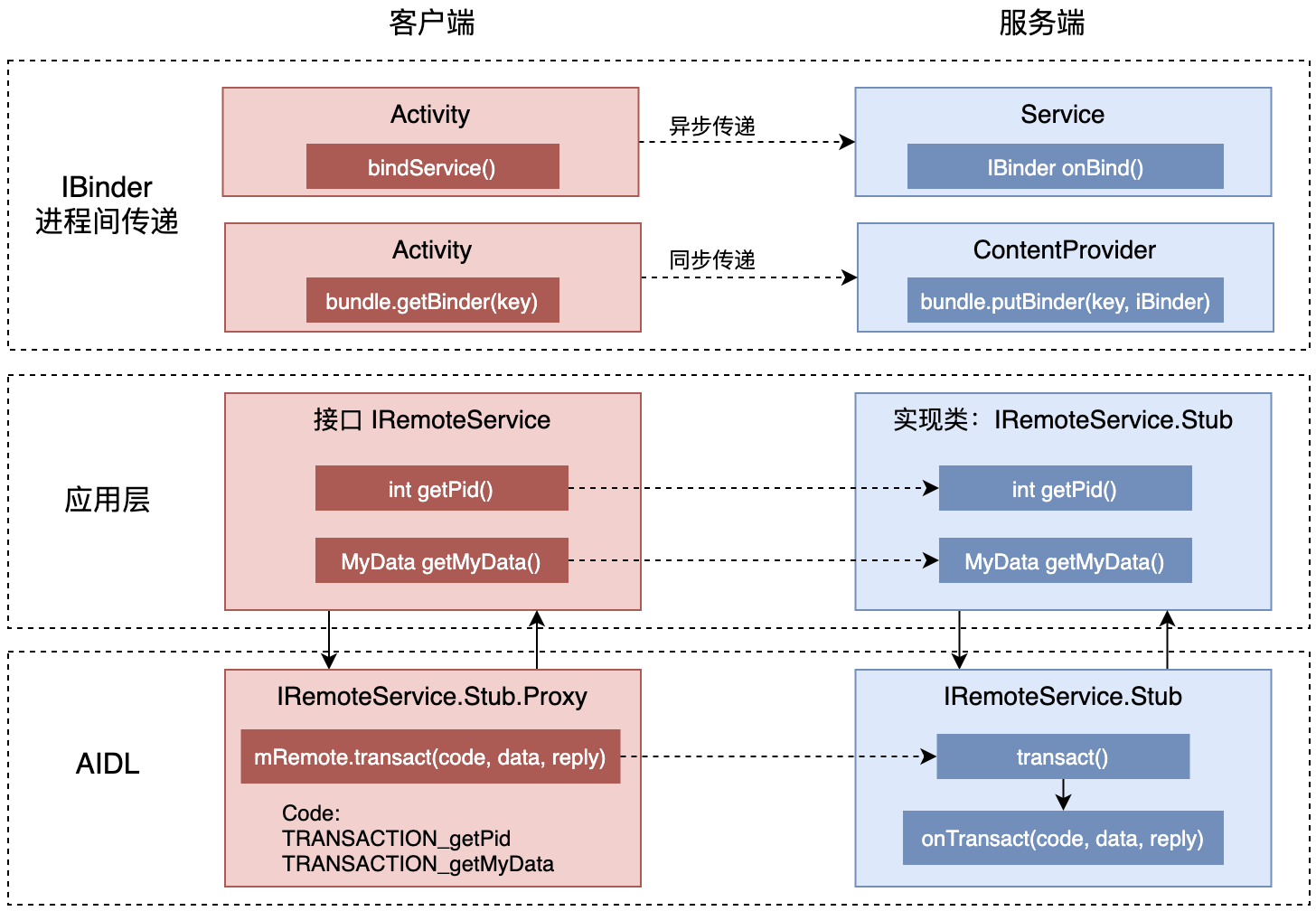
Binder IPC的内部实现
Android的跨进程通信:
- Zygote进程通过Socket机制通信
- 应用进程通过Binder IPC通信
进程之间之所以无法直接通信的原因是虚拟内存管理技术,进程分为两部分(以32位为例):
- 用户空间:0~3G,进程独有,即虚拟内存地址映射到的物理地址是独有,即使用不同的页表
- 内核空间:3G~4G,进程共享,即虚拟内存地址映射到的物理地址,其他进程也可以访问到,即使用同一个页表
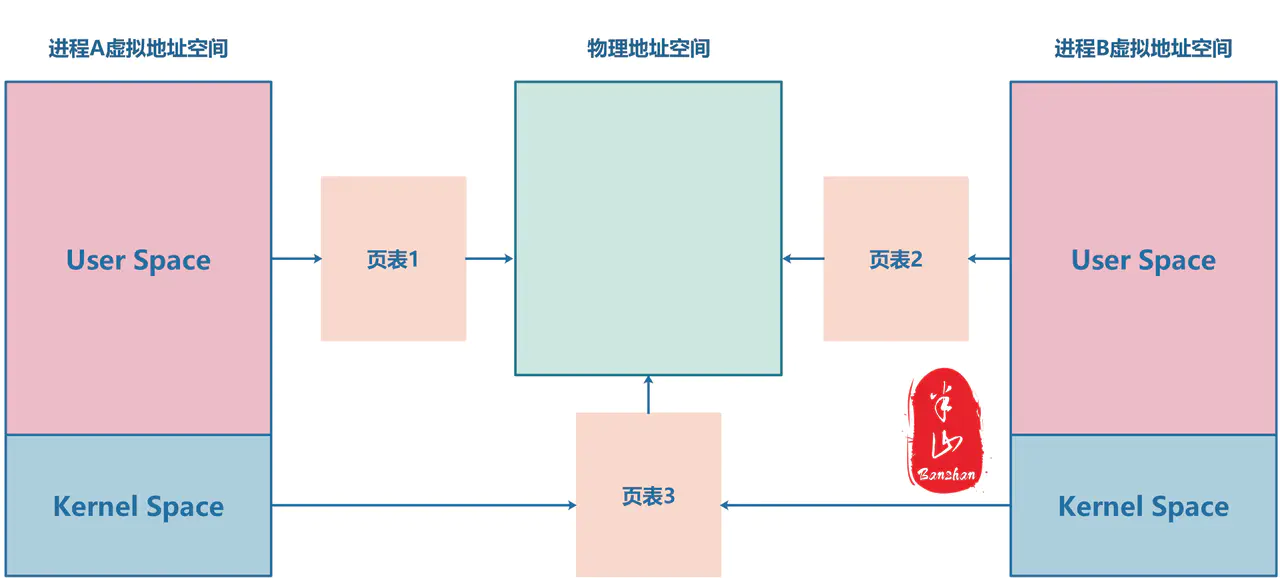
图片引用自Binder内存拷贝的本质和变迁
用户空间和内核空间都使用虚拟内存管理技术,由于所有的内核空间的地址,使用同一个页表,可访问相同的物理地址。所以进程间通信要借助内核空间,有两种方式:
- 共享内存:两个进程通过内核空间,共享同一块物理内存,都具有读写权限。需要处理同步问题。
- 内存拷贝:通常是两次拷贝,先从A进程的用户空间拷贝到共享的内核空间,再从共享的内核空间拷贝至B进程的用户空间。不用考虑同步问题,但性能有损失。
Binder IPC也是采用内存拷贝,但通过mmap(内存映射技术),只需拷贝一次,提升了性能。
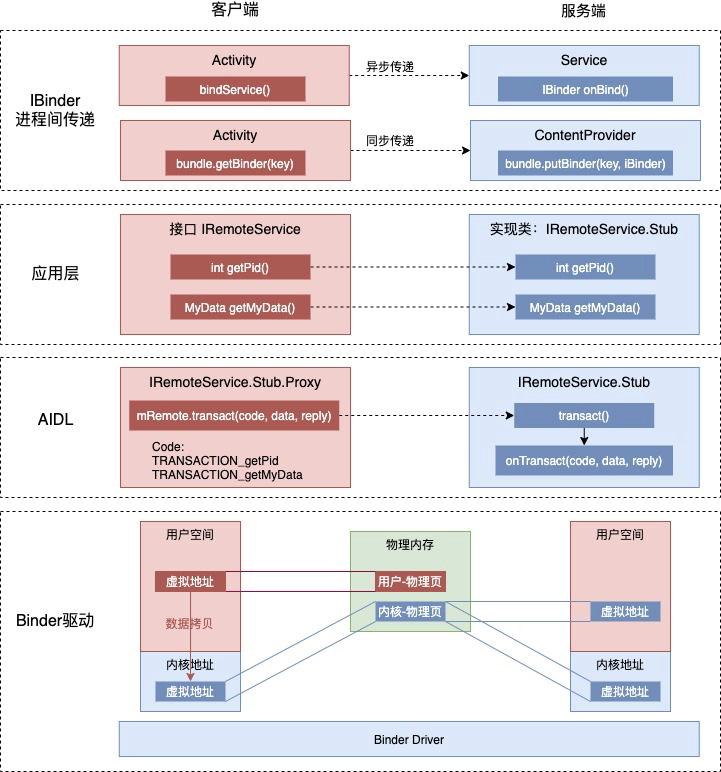
AIDL的限制
AIDL虽然让跨进程通信变得很简单,但无法实现运行时,动态扩展功能。每次AIDL的接口变化,都需要重新编译。
在VirtualApp里,通过IPC总线,实现了运行时动态的扩展能力。
IPC总线(IPCBus)
AIDL自动生成的Stub和Stub.Proxy的主要功能:
- 生成code,如TRANSACTION_getPid, TRANSACTION_getMyDatat,用于传输方法名的传输
- 传输方法名(即code)和方法参数,调用真正实现类对应的方法
总线实现
通过IPC总线实现这两个能力后,就可以实现运行时增加通信能力,整体框架如下:

动态生成code:替换AIDL的编译时生成
1
2
3
4
5
6
7
8
9
10
11
12
13
14
15
16
17
18
19
20
| class ServerInterface(val interfaceClass: Class<*>) {
private val codeToInterfaceMethod: SparseArray<IPCMethod>
private val methodToIPCMethodMap: Map<Method, IPCMethod>
init {
val methods = interfaceClass.methods
codeToInterfaceMethod = SparseArray(methods.size)
methodToIPCMethodMap = HashMap(methods.size)
for((index, method) in methods.withIndex()){
val code = Binder.FIRST_CALL_TRANSACTION + index
val ipcMethod = IPCMethod(code, method, interfaceClass.name)
codeToInterfaceMethod.put(code, ipcMethod)
methodToIPCMethodMap.put(method, ipcMethod)
}
}
...
}
|
客户端:通过动态代理替换IRemoteService.Stub.Proxy的功能
IRemoteService.Stub.Proxy 实现
1
2
3
4
5
6
7
8
9
10
11
12
13
14
15
16
17
18
19
20
21
22
23
24
| private static class Proxy implements com.ly.studydemo.binder.IRemoteService {
private android.os.IBinder mRemote;
...
@Override
public int getPid() throws android.os.RemoteException {
android.os.Parcel _data = android.os.Parcel.obtain();
android.os.Parcel _reply = android.os.Parcel.obtain();
int _result;
try {
_data.writeInterfaceToken(DESCRIPTOR);
boolean _status = mRemote.transact(Stub.TRANSACTION_getPid, _data, _reply, 0);
if (!_status && getDefaultImpl() != null) {
return getDefaultImpl().getPid();
}
_reply.readException();
_result = _reply.readInt();
} finally {
_reply.recycle();
_data.recycle();
}
return _result;
}
...
}
|
IPCBus的动态代理实现
1
2
3
4
5
6
7
8
9
10
11
12
13
14
15
16
17
18
19
20
21
22
23
24
25
26
27
28
29
30
31
32
33
34
35
36
| fun <T> get(interfaceClass: Class<*>): T? {
val serverInterface = ServerInterface(interfaceClass)
val binder = getService(interfaceClass.name) ?: return null
return Proxy.newProxyInstance(
interfaceClass.classLoader,
arrayOf(interfaceClass),
IPCInvocationBridge(serverInterface, binder)
) as T
}
class IPCInvocationBridge(val serverInterface: ServerInterface, val binder: IBinder) : InvocationHandler {
override fun invoke(proxy: Any?, method: Method?, args: Array<Any>?): Any? {
val ipcMethod = serverInterface.getIPCMethod(method)
?: throw IllegalStateException("Can not found the ipc method : " + method?.declaringClass?.name + "@" + method?.name)
return ipcMethod.callRemote(binder, args)
}
}
fun callRemote(server: IBinder, args: Array<Any>?): Any? {
val data = Parcel.obtain()
val reply = Parcel.obtain()
try {
data.writeInterfaceToken(interfaceName)
data.writeArray(args)
server.transact(code, data, reply, 0)
reply.readException()
val result = reply.readValue(this.javaClass.classLoader)
return result
} finally {
data.recycle()
reply.recycle()
}
}
|
服务端:通过Binder实现类TransformBinder替换IRemoteService.Stub的功能
IRemoteService.Stub实现
1
2
3
4
5
6
7
8
9
10
11
12
13
14
15
16
17
18
19
20
21
22
23
24
25
26
27
28
29
30
31
32
33
34
35
| public static abstract class Stub extends android.os.Binder implements com.ly.studydemo.binder.IRemoteService {
...
@Override
public boolean onTransact(int code, android.os.Parcel data, android.os.Parcel reply, int flags) throws android.os.RemoteException {
java.lang.String descriptor = DESCRIPTOR;
switch (code) {
case INTERFACE_TRANSACTION: {
reply.writeString(descriptor);
return true;
}
case TRANSACTION_getPid: {
data.enforceInterface(descriptor);
int _result = this.getPid();
reply.writeNoException();
reply.writeInt(_result);
return true;
}
case TRANSACTION_getMyData: {
data.enforceInterface(descriptor);
com.ly.studydemo.binder.MyData _result = this.getMyData();
reply.writeNoException();
if ((_result != null)) {
reply.writeInt(1);
_result.writeToParcel(reply, android.os.Parcelable.PARCELABLE_WRITE_RETURN_VALUE);
} else {
reply.writeInt(0);
}
return true;
}
default: {
return super.onTransact(code, data, reply, flags);
}
}
}
}
|
IPCBus里的TransformBinder实现
1
2
3
4
5
6
7
8
9
10
11
12
13
14
15
16
17
18
19
20
21
22
23
24
25
26
27
28
29
30
31
32
| class TransformBinder(val serverInterface: ServerInterface, val server: Any) : Binder() {
override fun onTransact(code: Int, data: Parcel, reply: Parcel?, flags: Int): Boolean {
if(code == Binder.INTERFACE_TRANSACTION) {
reply?.writeString(serverInterface.getInterfaceName())
return true
}
val ipcMethod = serverInterface.getIPCMethod(code)
?: return super.onTransact(code, data, reply, flags)
ipcMethod.handleTransact(server, data, reply)
return true
}
}
fun handleTransact(server: Any, data: Parcel, reply: Parcel?){
data.enforceInterface(interfaceName)
val parameters = data.readArray(this.javaClass.classLoader)
try {
val res: Any?
if (parameters == null) {
res = method.invoke(server)
} else {
res = method.invoke(server, parameters)
}
reply?.writeNoException()
reply?.writeValue(res)
}catch (e: Exception) {
reply?.writeException(e)
}
}
|
Binder的单例管理
因为跨进程通信最终还是通过IBinder实现,每个接口对应的IBinder对象应该复用,全局单例。
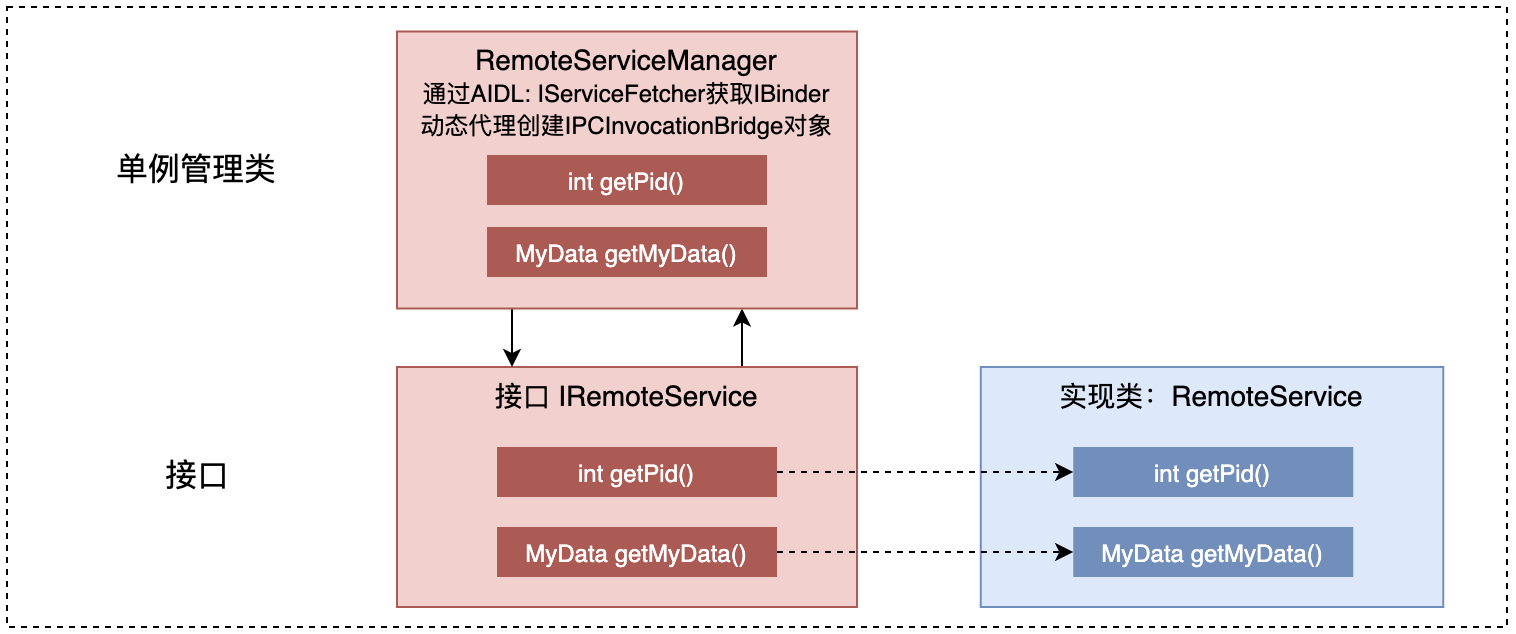
AIDL搭桥传输IBinder对象
首先通过AIDL创建跨进通信,用于传输动态IPC的Binder对象。

- 通过ContentProvider传递AIDL(IServiceFetcher)对象
- 通过AIDL(IServiceFetcher)传递动态的Binder对象
总结
IPCBus的关键是把编译时生成的code,改为动态生成,其他机制与自动生成的IRemoteService.Stub里的机制一样。
参考
- Binder内存拷贝的本质和变迁
- VirtualApp







